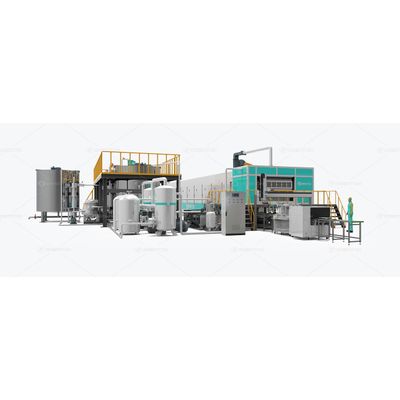

- Home
- Companies
- Beston Group Co., Ltd.
- Articles
- Automation and Robotics in Modern Fully ...

Automation and Robotics in Modern Fully Automatic Egg Tray Machine Operations
Integration of Intelligent Systems in Pulp Molding
The deployment of automation and robotics has transformed the operational dynamics of the fully automatic egg tray machine. In contrast to earlier generations of manual or semi-automatic equipment, modern systems operate with minimal human intervention, relying heavily on programmable logic controllers (PLCs), servo actuators, and real-time feedback mechanisms to execute precise manufacturing cycles.
These intelligent systems ensure uniformity across forming, drying, and stacking stages. Through synchronized movements and calibrated timing, they significantly reduce variability, enhance dimensional stability, and improve overall product yield. The incorporation of sensor-driven feedback loops allows for adaptive control, compensating for fluctuations in pulp consistency, mold temperature, or ambient humidity in real time.
Robotic Handling and Post-Forming Efficiency
Robotic integration extends beyond forming units. In advanced installations, robotic arms are deployed for tray collection, stacking, and palletization. This eliminates manual handling, which is often a bottleneck in high-throughput environments. With vision systems and adaptive grippers, robotic handlers can accommodate variations in tray orientation or minor deformities, maintaining flow continuity without operator oversight.
This automation reduces breakage, ensures optimal use of drying line space, and facilitates just-in-time packaging. For facilities targeting export-grade packaging, robotic assistance ensures conformity to precise stacking patterns and compression tolerances required during transport. This is also a factor that affects pulp molding machine price.
Enhanced Synchronization in High-Capacity Lines
A fully automatic egg tray machine functions as a multi-stage system encompassing pulp preparation, molding, drying, and stacking. Automation unifies these components into a coherent operational flow, where each subsystem is interconnected via industrial communication protocols such as Modbus or Ethernet/IP. This enables centralized control and real-time diagnostics, allowing operators to oversee the entire line from a single interface.
With automation, cycle times are optimized for peak throughput without compromising quality. Vacuum system activation, water drainage timing, and mold rotation are all algorithmically adjusted for load balancing. Drying systems—whether metal or multi-layer conveyor configurations—are also regulated to maintain optimal thermal gradients, reducing energy consumption while ensuring uniform drying.
Predictive Maintenance and Operational Longevity
Advanced automation platforms now incorporate predictive maintenance modules. Vibration sensors, thermal imaging, and current analysis tools monitor the health of motors, pumps, and gearboxes. Anomalies are flagged before they escalate into failures, minimizing unplanned downtime and extending machine lifespan.
This proactive approach to maintenance is particularly critical in regions with limited technical labor availability. By forecasting maintenance schedules based on usage patterns and wear rates, production managers can allocate resources more effectively and reduce spare parts inventory pressure.
Workforce Reallocation and Skill Evolution
While the fully automatic egg tray machine minimizes manual tasks, it elevates the need for operators skilled in interface management, systems diagnostics, and digital calibration. Workforce training now centers around human-machine interface (HMI) navigation, control logic interpretation, and safety compliance within automated cells.
This transition supports higher-value employment and redefines labor utility within the pulp molding industry. Operators evolve from repetitive task execution to oversight roles, focusing on quality assurance, process optimization, and systems coordination.
Conclusion
The incorporation of automation and robotics into fully automatic egg tray machine operations has redefined manufacturing benchmarks in the pulp molding sector. Through enhanced precision, throughput optimization, and predictive intelligence, these systems offer scalable solutions for industrial producers aiming for efficiency, consistency, and reduced operational overhead. As automation technologies continue to evolve, the role of human operators will shift further towards analytical and supervisory capacities, driving smarter production ecosystems.
